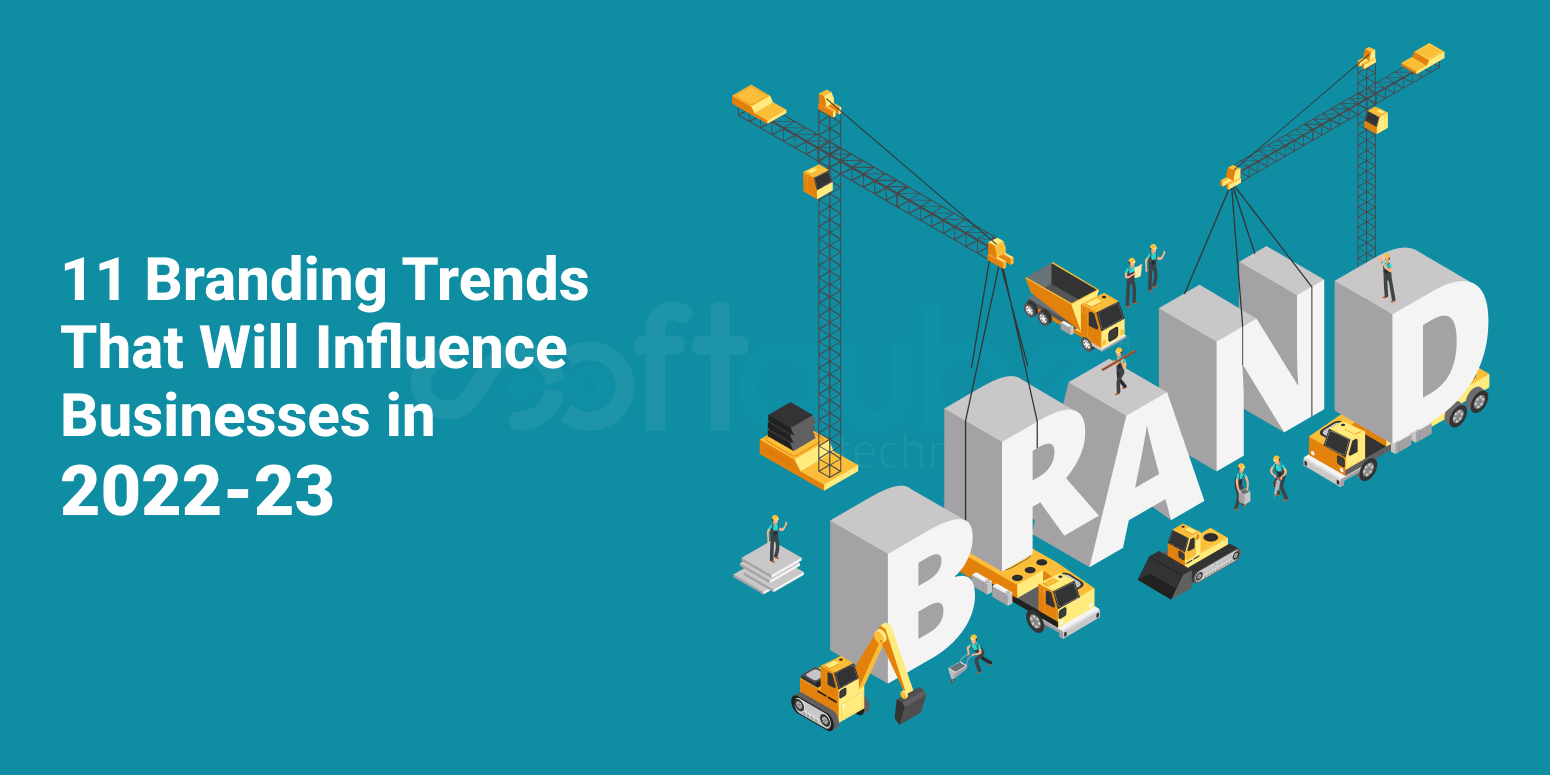11 Branding Trends That Will Influence Businesses in 2022-23
February 21, 2022

Branding is one such element that sets your business apart from your competitors. In the present era of digital distractions, an intuitive logo or a catchy brand name isn’t enough to keep modern customers hooked to your product. With the added Covid disruptions creating the unprecedented crisis, it becomes more difficult to catch their attention.
You cannot fix this problem with perfection. However, a good start can be to learn about the latest branding trends that can help gain more attention from your target audience. To begin with, let us find out the most important branding trends and developments in the world of logo designs and social media hashtags to frame better customer-driven strategies and branding technologies.
The Top 11 Branding Trends of the Year 2022
What sets your company apart from the competitors is adopting a solid branding strategy. That is a reason why every company takes a lot of effort to come up with an enticing brand name, logo, and impressive color schemes. To build a desirable perception in the minds of the customers, you sometimes need to move beyond the aesthetics.
Nowadays, customers want a great substance that sounds with some purpose. The topmost challenge every brand manager faces today is to create the right message for the right audience with a personalized brand voice.
Get in tune with the following trends to strategize your branding process amid the neverending challenges arising across the globe.
Adapt to the Logo
Your company needs to show up at all those platforms where customers engage. It is going beyond the physical realm and promoting online via advertisement. To thrive in the digital age, you must have a website and remain present on several social networking platforms.
That is the reason now many companies are choosing to create shape-shifting log designs. Your logos need to change their size, complexity, or color depending on what you are using them for.
By having these different variations, you can ensure consistency no matter what medium your logo is viewed on. Meaning, it allows you to make your logo work regardless of the layout it is being used on. Moreover, it allows your customers to recognize your branding in different ways, increasing the chance of brand recall.
Visual Content Brand
Humans are naturally better at retaining images than any other form of content. Looking from the brand perspective, every other kind of visual content cannot give the same response from the target audience. Visual content such as GIFs, infographics, charts, and videos can generate new leads more efficiently on social media.

They have a better shot by getting noticed as compared to ads. They simply lay out what products you have to offer. Before you leverage this strategy, be sure to create visuals that reflect the aesthetic of your brand. For example, if it’s an infographic, use your official font style or decorate it using your color scheme. If it’s a video, add your logo to the bottom corner of the video. This way, customers know that you produced the content and help you subtly advertise your brand.
Social Media Branding
Internet accessibility has paved the way for an always-on social media culture. This helps in site transformation like Facebook, Pinterest, YouTube, Twitter, and Instagram into prime spots for building your brand. And that is why 90% of organizations leverage social media for brand awareness.
And therefore, you must pay attention to how to showcase your products and services on various platforms. The best way to begin is to zero in on all those sites where your customers mostly visit and check out every social network platform in depth. All the platforms focus on different forms of content.

After this, you’ll need to create a consistent visual theme for your accounts. This means creating a color scheme and having a standard for photo editing and layout to give your brand a more solid identity.
So, develop a voice for your brand. Be sure to create a lingo that speaks to your target audience and just stick to it.
Online Communities
The pandemic has led to building up online communities that become an essential part of branding. This is because communities provide customers with various things that were needed during the pandemic.
 Your customers rely on these online community platforms to a great extent by interacting with each other. The interaction happens by social comments, phone calls, instant messages, or even via hashtags on their posts. And this is the place where you can connect your clients with like-minded individuals and enhance your brand relations with them. Building an online community is a proven strategy that can be adopted for gaining higher ROI. Aside from boosting retention, online communities, in a similar light to hashtags, are also a great way to understand the wants and needs of your customers. This reduces the need to extensively monitor social media for trends as you can see what they are discussing right on your servers.
Your customers rely on these online community platforms to a great extent by interacting with each other. The interaction happens by social comments, phone calls, instant messages, or even via hashtags on their posts. And this is the place where you can connect your clients with like-minded individuals and enhance your brand relations with them. Building an online community is a proven strategy that can be adopted for gaining higher ROI. Aside from boosting retention, online communities, in a similar light to hashtags, are also a great way to understand the wants and needs of your customers. This reduces the need to extensively monitor social media for trends as you can see what they are discussing right on your servers.
Official Hashtags
Another branding trend that has come up gaining higher importance is using official hashtags. There are 7 hashtags out of ten that are branded on Instagram alone (Reports – Omnicore, 2021).
 To ask your customers to post their recent purchases from your company along with using hashtags, can enhance your follower’s reach. You can also share screenshots of these user-generated posts on your social media page just to encourage other customers to share their experience with your brand and persuade them to do purchases.
To ask your customers to post their recent purchases from your company along with using hashtags, can enhance your follower’s reach. You can also share screenshots of these user-generated posts on your social media page just to encourage other customers to share their experience with your brand and persuade them to do purchases.
In addition to engaging customers, hashtags can also be used to gauge the pulse of your consumers. Monitoring these closely can give you a better idea of how they perceive your brand.
Brand Inclusivity
Customer expectations are getting highly evolved with concepts like diversity, body positivity, and inclusivity. For example, the personal care brand Dove, cosmetics brand Fenty Beauty, and underwear company ThirdLove, promote inclusivity to a considerable extent.
These brands make it a point to ask real women to appear on their ads instead of hiring picture-perfect models. For the same, they launch various ad campaigns aiming to shatter beauty stereotypes. The women get featured belonging to different ages, sizes, and shapes.
If the brand doesn’t cater to women, you can make your brand inclusive through other means. This allows you to tap customers from different backgrounds.
Brand Authenticity
Hitting customer trust has seen a downward trend in a couple of years. A report from Stackla on consumer content reveals that 86% of shoppers view authenticity as a huge factor in purchasing decisions. The same study shows a report that a whopping 90% of millennials opine that authenticity is important in branding and prefer “real and organic” companies over those that seek to be perfect and packaged.
The data here reveals that photoshopped ads, using picture-perfect models, and heavily edited commercials are no longer alluring the modern shoppers. They would rather do business with companies that are honest with them
Humanized Brand Personality
Customers take a lot of time to trust brands. If you wish for them to buy your products, start humanizing your brand. Because that is something that customers would want to see particularly with the ongoing pandemic. Attaching a personality to your brand is one of the most tried and tested brand marketing trends of all time.
For example, Old Spice, an American brand selling male grooming products believes in implementing this strategy. Across all posts, ads, and websites, the company consistently is playful and wacky. They keep their customers from getting bored with the content that they publish.
Technology Embed With Branding
Technology is influencing to a large extent our daily lives and to the industries. Marketers and brand managers have used technology for various aspects of branding for years. However, in these past years, there are various emerging technologies that companies have been slowly adapting to further optimize branding.
 Some of the top tech that marketers are incorporating in their operations are mobile applications (68%), voice assistants (40%), and virtual reality (37%). These will allow them to accommodate internet users that rely on their smartphones as well as create better experiences for their potential customers and existing clients. In addition, these new technologies can help them stay relevant in this fast-paced landscape (Bynder, 2018).
Some of the top tech that marketers are incorporating in their operations are mobile applications (68%), voice assistants (40%), and virtual reality (37%). These will allow them to accommodate internet users that rely on their smartphones as well as create better experiences for their potential customers and existing clients. In addition, these new technologies can help them stay relevant in this fast-paced landscape (Bynder, 2018).
Partner with Micro-Influencers
Rachel David talks at TEDx that influencers play a very large role in modernizing brand marketing strategies. All you need is the right influencer, and then you need not worry about reaching out to the audiences that show interest in your niche. These people have already established themselves as an authority in their field. They have an army of followers and engaged audiences.
The gaming industry perhaps utilizes influencer partnerships the most, thanks to its large market share in the video streaming space. It comes as no surprise that 79% of brand managers have invested in influencer marketing over the past year while 22% have planned to utilize it for the first time (Bynder, 2018).
Initiate Brand Sustainability
The studies reveal that 88% of customers believe that companies can influence societal change. They should therefore take the lead in addressing environmental issues by way of providing more sustainable products.
Plus, shoppers nowadays are more conscious about what they purchase. They make it a point to opt for more sustainable brands whenever they can. 23% of shoppers are now willing to pay an extra 1% to 5% for sustainable products (Statista, 2019). This is echoed by a recent joint study by IBM and the National Retail Federation where they found that 69% of North American consumers and 8 in 10 shoppers globally are willing to pay extra for eco-friendly products (IBM, 2020).
A Wrap-Up
Gaining the deep trust and loyalty of modern customers has now become harder than ever. With a lot of distractions taking place around and the uncertain behavior of customers due to the Covid crisis, the traditional branding strategies are slowly becoming powerless.
It takes a huge effort to build a brand. The starters must focus less on how a brand looks and should work on how the brand acts and how it can solve the problems in society. Companies are working on fostering authentic consumer experiences to meet up the demands.
This just goes to show that brand managers and marketers have to go above and beyond to ensure they capture and retain the attention of their target audience.
To find out more insights on the trends in the industry, keep reading our blogs on a regular basis. We ensure you get an in-depth insight on the business perspectives and can help you shape your business into a better productive model.
Share on








